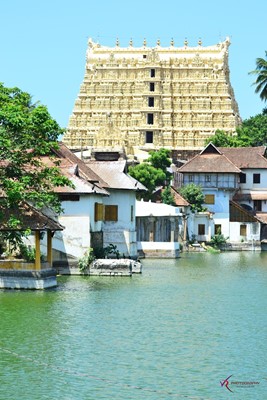Sree Padmanabhaswamy Temple
Sree Padmanabhaswamy Temple is an ancient Hindu temple located in the city of Thiruvananthapuram, Kerala. Renowned for its magnificent architecture and spiritual significance, this temple is dedicated to Lord Vishnu and is one of the 108 Divya Desams (holy abodes) mentioned in the Vaishnavite tradition. With its stunning gopuram (tower), intricate carvings, and rich history, Sree Padmanabhaswamy Temple is not only a place of worship but also a symbol of Kerala's cultural heritage, attracting pilgrims and tourists alike.
Why Visit Sree Padmanabhaswamy Temple
- Architectural Marvel: Admire the intricate architecture and detailed sculptures that adorn the temple, showcasing the Dravidian architectural style.
- Historical Significance: Explore the temple's fascinating history, which dates back to the 16th century, and its connection to the royal family of Travancore.
- Spiritual Atmosphere: Experience the serene and divine ambiance that envelops the temple, making it a perfect place for meditation and reflection.
- Rich Treasures: Discover the temple's wealth of treasures, including gold, jewels, and ancient artifacts, that reflect its historical importance.
- Festivals and Celebrations: Witness vibrant festivals, especially the annual festival held in the Malayalam month of Medam, which showcases traditional rituals and cultural events.
Best Time to Visit
The best time to visit Sree Padmanabhaswamy Temple is from October to March when the weather in Thiruvananthapuram is pleasant and suitable for sightseeing. The temple also attracts many visitors during major festivals, enhancing the cultural experience.
How to Get There
- By Road: Sree Padmanabhaswamy Temple is located in the heart of Thiruvananthapuram and is easily accessible by road. Local taxis and auto-rickshaws are available for transport within the city.
- By Train: The nearest railway station is Thiruvananthapuram Central, which is well-connected to major cities in Kerala and beyond. From there, you can take a taxi or local transport to reach the temple.
- By Air: The nearest airport is Trivandrum International Airport, about 5 km away, offering domestic and international flights. Taxis and auto-rickshaws are available for transfer to the temple.
Tips for Visitors
- Dress Modestly: As a place of worship, visitors are required to dress modestly. Traditional attire is recommended, and men are often required to remove their shirts.
- Plan Your Visit: Check the temple’s opening hours and plan your visit accordingly, as entry is restricted at certain times.
- Photography Restrictions: Be aware that photography is generally not allowed inside the temple premises, so enjoy the moment and respect the rules.
- Participate in Rituals: Engage in the temple rituals and traditions, such as offering prayers and participating in the aarti (light offering), to enrich your experience.
- Respect Local Customs: Familiarize yourself with the customs and practices of the temple to ensure a respectful visit.
Sree Padmanabhaswamy Temple stands as a beacon of devotion and architectural brilliance in Kerala. With its historical significance, spiritual ambiance, and stunning beauty, it offers visitors an unforgettable experience that connects them to the rich cultural heritage of the region.
Visitors' Reviews
None of our visitors shared their reviews on Sree Padmanabhaswamy Temple yet. However, we have collected 10 ratings from external sources on this landmark.
Write a Review on this LandmarkSocial Media
Click on the links below to follow Sree Padmanabhaswamy Temple on various social media platforms.








